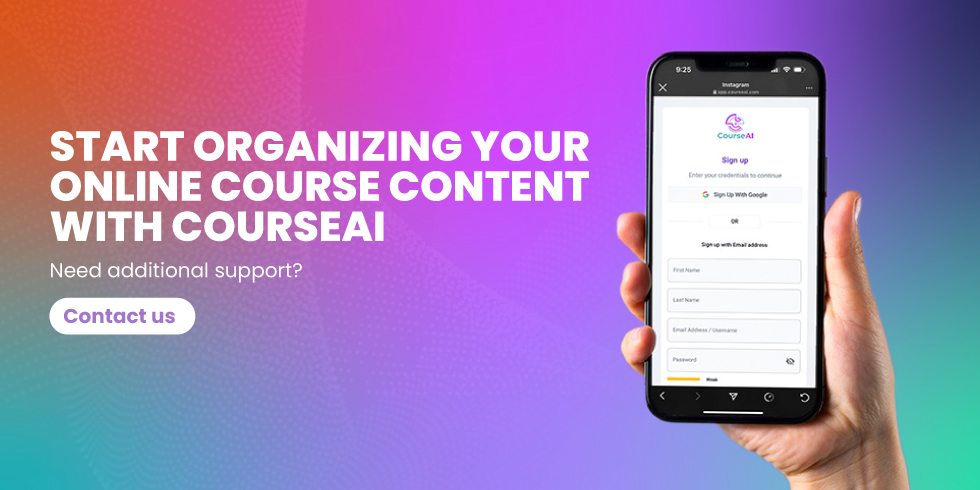In the ever-expanding landscape of online education, the organization of course content plays a pivotal role in shaping the learning experience for students. With CourseAI leading the charge, let’s delve into the best practices for organizing online course content to maximize student engagement, comprehension, and retention.
Understanding the Importance of Content Organization
Effective content organization is more than just arranging topics in a logical sequence. It’s about creating a cohesive learning journey that guides students from the basics to advanced concepts, ensuring they grasp each concept before moving on to the next.
CourseAI empowers educators to structure their course content in a way that fosters meaningful learning experiences for students of all levels.
The Crucial Role of Content Organization in Online Learning
Proper content organization transcends traditional teaching methodologies, leveraging the digital platform to enhance accessibility and engagement. It ensures that learners are not just passive recipients but active participants in their educational journey, facilitating a more personalized and interactive learning environment.
Key Components of Effective Content Organization:
- Structured Learning Paths: Tailoring the course layout to guide students logically from basic concepts to advanced applications.
- Interactive Elements: Incorporating interactive components like quizzes and simulations to reinforce learning.
- Multimedia Resources: Utilizing videos, audio, and infographics to cater to different learning styles.
Best Practices for Organizing Online Course Content

Now that you have a good overview of just how important organizing your online course content is, it’s time to look at the best methods that top-earning course creators and educators use to promote their learning platform(s).
The following are the most effective practices when organizing your online course content:
- Start with Clear Learning Objectives
- Chunk Content for Digestible Learning
- Use a Logical Progression
- Incorporate Multimedia Elements
- Provide Clear Navigation
- Offer Supplemental Resources
Let’s explore these in detail and see how CourseAI fits your project’ needs.
Start with Clear Learning Objectives
Goal: The objective here is not just to enumerate what each module covers but to connect every lesson to an actionable skill or knowledge gain. By setting clear, measurable goals, educators help students understand the purpose behind each lesson and how it fits into their broader learning journey. CourseAI enhances this process by offering tools that assist educators in crafting precise and motivational objectives. This clarity in goals sets a focused direction right from the start, aligning student efforts with desired outcomes.
Benefits with CourseAI:
- Streamlines goal-setting with intuitive interfaces.
- Promotes alignment between course content and learning objectives.
Chunk Content for Digestible Learning
Goal: In an era of information overload, the ability to chunk course content into manageable pieces is invaluable. This strategy aids in preventing cognitive overload by allowing students to concentrate on one concept at a time, leading to improved comprehension and retention rates.
CourseAI simplifies this process, providing educators with the tools to efficiently organize and present content in a way that’s easy for students to absorb, understand, and apply.
Benefits with CourseAI:
- User-friendly content structuring.
- Facilitates the creation of a paced learning environment.
Use a Logical Progression
Goal: A well-structured course guides learners through a natural progression of knowledge, starting with foundational concepts and gradually introducing more complex topics. This logical flow ensures that students build on what they’ve learned, making the acquisition of advanced skills more intuitive.
CourseAI’s curriculum mapping tools are instrumental in helping educators design these coherent learning paths, ensuring a smooth educational journey that leads students from basic understanding to mastery.
Benefits with CourseAI:
- Advanced mapping tools for curriculum planning.
- Support for structuring courses with progressive complexity.
Incorporate Multimedia Elements
Goal: Today’s learners expect dynamic and interactive content. Integrating multimedia elements like videos, quizzes, and infographics caters to various learning styles, making lessons more engaging and memorable.
CourseAI’s multimedia integration capabilities empower educators to diversify their teaching methods, enhancing the learning experience with content that not only informs but also captivates and inspires.
Benefits with CourseAI:
- Easy integration of various multimedia formats.
- Tools to create interactive and visually appealing content.
Provide Clear Navigation
Goal: The ease with which students can navigate course materials directly impacts their learning efficiency and satisfaction. A well-organized course structure, complemented by clear navigation cues, ensures that learners can easily find the information they need without frustration.
CourseAI’s interface and navigation tools are designed with the user experience in mind, making it straightforward for students to move through the course content and track their progress.
Benefits with CourseAI:
- Intuitive design for effortless course exploration.
- Features to help students monitor their learning journey.
Offer Supplemental Resources
Goal: Enriching the core course material with additional resources broadens the learning experience, allowing students to explore topics in greater depth.
Whether it’s recommended readings, case studies, or external links, these supplemental materials cater to diverse interests and learning preferences, enhancing the educational value of the course.
With CourseAI, educators can easily integrate and organize a variety of resources, providing students with a comprehensive and immersive learning environment.
Benefits with CourseAI:
- Seamless organization of supplemental materials.
- Tools to enhance course content with diverse learning aids.
The CourseAI Advantage
With CourseAI, educators have access to a comprehensive suite of tools and features designed to streamline the process of organizing online course content.
From content structuring and curriculum mapping to multimedia integration and navigation design, CourseAI empowers educators to create engaging and effective learning experiences for their students.
Conclusion

Effective organization of online course content is essential for creating engaging, meaningful, and effective learning experiences for students. By following best practices outlined in this guide, educators can leverage CourseAI to create courses that inspire, educate, and empower students to reach their full potential.
So why wait? Start organizing your online course content with CourseAI today and unlock the true potential of online education.
Need additional support? Contact CourseAI today and find the answers to your important questions.

